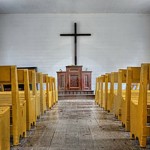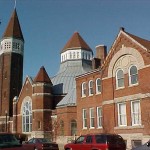The internment of Americans of Japanese descent after the attack on Pearl Harbor in December 1941 is one of the darker chapters of American history.
A Protestant church headquartered in Indianapolis, the Disciples of Christ was at the forefront of an interdenominational movement to uphold the rights of the more than 100,000 relocated people—70 percent of whom were American citizens.
At church conventions in 1942 and again in 1944, delegates passed resolutions calling for the restoration of democratic principles and justice.
The church’s leadership worked in tandem with other faith-based organizations and the US War Relocation Authority to facilitate a successful transition for those dispersed from internment camps on the West Coast to new lives in the Midwest, where more Japanese-Americans resettled during the 1940s than anywhere else in the nation.
The state the church called home, however, was the exception to the trend. Although Indiana’s Japanese-American population grew almost tenfold over the course of the relocation, fewer Japanese-Americans resettled in all of Indiana than in the single city of Des Moines, Iowa.
Resistance from the Indianapolis-based International Teamsters Union–among other labor unions— along with the Indiana Chapter of the American Legion created a chilly reception for Japanese-Americans thinking of relocating in the Hoosier State.
One publication lauded efforts to block employers in Michigan City and South Bend from hiring relocated workers: “No Jap Help Wanted Here,” ran the January 1944 headline in International Teamster, “Unions Keep Them Out of Two Mid-West Cities.”
A consortium of Indianapolis religious groups and public service agencies, nonetheless, worked against prevailing prejudice to welcome the dispersed population, partnering with the War Relocation Agency when it opened a field office on the sixth floor of the Circle Tower.
In July 1943, a Disciples missionary led several Japanese-Americans on a tour of rural Indiana communities to gauge sentiment and promote assimilation, meeting with 1700 people over the course of the tour.
Old copies of The Disciple Herald, a newsletter for members of the Japanese-American diaspora, record evidence of employment opportunities that existed in Indiana–an Otto Frenzel of Carmel, for example, offered $150 per month and a five-room bungalow in exchange for a couple’s services.
Of the 25,000 Japanese-Americans who resettled in the Midwest, just 254 made their new home in the Hoosier State.






















